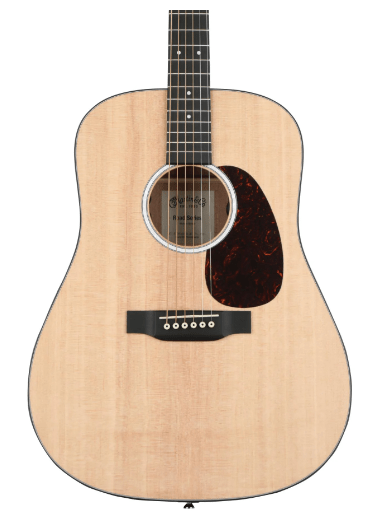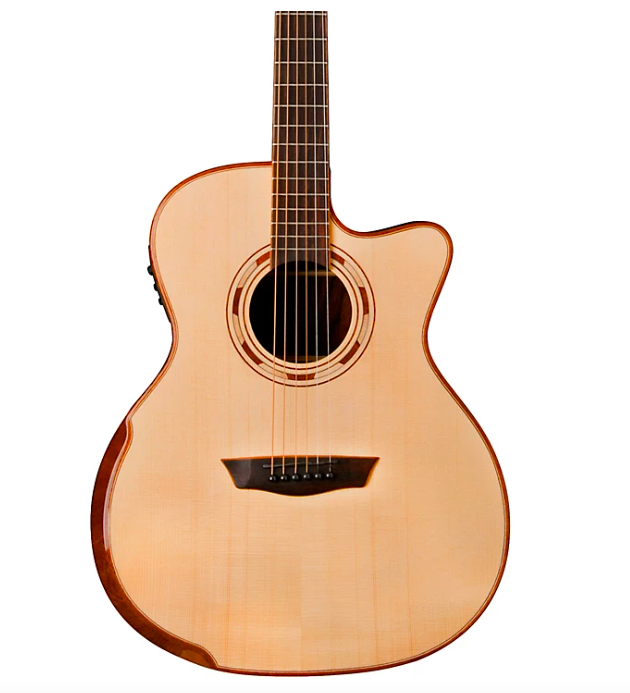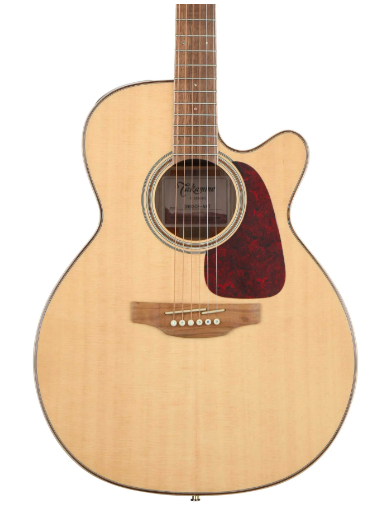When you buy through our links, we may earn an affiliate commission.
It’s commonly assumed that you need to fork out thousands of dollars to get an outstanding acoustic guitar, but this isn’t necessarily the case.
If you’re searching for an acoustic guitar that produces a well-rounded tone and feels luxurious to play, there are some great affordable options out there.
Our top pick is the stunning Taylor GS Mini-e, combining rich tonality, impeccable onboard electronics, and smooth playability.
In this article, you’ll find a variety of the best acoustic guitars for under 1000 dollars. We’ve included options to suit all musical genres, playing styles, and skill levels.
Quick Summary of the Best Acoustic Guitars Under $1000
- Taylor GS Mini-e Koa (Best Overall)
- Martin D-10E Road Series Dreadnought (Best Onboard Electronics)
- Washburn Comfort G25SCE (Best for Fingerstyle)
- Takamine GN93CE NEX (Most Comfortable Guitar)
- Epiphone Hummingbird Studio (Best Budget Option)
Best Acoustic Guitars Under $1,000
1. Best Overall – Taylor GS Mini-e Koa

SPECS
- Body Shape: Grand Symphony Mini
- Electronics: ES-B Preamp
- Fingerboard Wood: Ebony
- Scale Length: 23.5"
As one of the longest-standing and most highly regarded instrument manufacturers in the world, Taylor knows how to build some of the best acoustic guitars. The GS Mini-e is remarkably versatile for a smaller-bodied model, and it’s very reasonably priced.
One of the first things that captured our attention when experimenting with this guitar was how comfortable the sapele neck is to hold. Martin has opted for a standard carve neck profile, which I found promotes fast and accurate playing.
With a smooth ebony fingerboard that consists of 20 frets, the GS Mini-e is very easy to navigate. Despite having a reduced-size grand symphony mini body shape, I was particularly impressed by its full-bodied projection and wide dynamic range.
This guitar oozes elegance with an exquisite tonewood blend of solid Hawaiian koa for the top, layered koa for the back and sides, and ebony for the bridge. To top it off, when I plugged it into my amp via the ES-B preamp, it retained all of the desirable qualities of its unplugged tone.
What we like about it:
- The guitar is made from a combination of the highest-quality tonewood materials including a smooth ebony fingerboard.
- Its warm and full-bodied acoustic tone is carried over when plugged into an amp.
- The grad symphony mini body size makes the guitar easy to transport.
What we didn’t like about it:
- Compared to full-sized acoustic guitars, the GS Mini-e has a slightly lower maximum volume when unplugged.
Interested in Buying a Guitar Stand? See Some of Our Favorite Foldable Guitar Stands Here
2. Best Onboard Electronics – Martin D-10E Road Series Dreadnought

SPECS
- Body Shape: Dreadnought
- Electronics: Fishman MX-T
- Fingerboard Wood: Richlite
- Scale Length: 25.4"
I’ve played Martin guitars many times over the years, and they never disappoint. The D-10E from the brand’s acclaimed Road Series is a dreadnought guitar that delivers a warm sound and feels amazing to play.
This Martin guitar really comes into its own when it is played delicately. I experimented with various fingerstyle techniques and open tunings and was left awestruck by the rich tone this guitar delivers, which is largely down to the tonewoods that it is constructed from.
The dreadnought body shape is renowned for its high volume and full-bodied tone. Martin has made it with a solid sitka spruce top, sapele back and sides, and spruce C bracing that is non-scalloped, resulting in unrivaled robustness.
With MX-T electronics made by the legendary Fishman brand, every note you play on the richlite fingerboard can be amplified with accuracy and clarity. I love the fact that Martin has stayed true to its early dreadnought design while adding some modern features to this guitar.
What we like about it:
- The classic dreadnought design evokes memories of early Martin acoustic guitars
- The midrange frequencies are bold, warm, and full-bodied
- This guitar is as robust and durable as they come
What we didn’t like about it:
- This acoustic guitar is larger than other varieties, like the parlor guitar, making it more difficult to transport
3. Best for Fingerstyle – Washburn Comfort G25SCE

SPECS
- Body Shape: Grand Auditorium
- Electronics: Fishman Presys+ 501T
- Fingerboard Wood: Ovangkol
- Scale Length: 25.3"
In my experience, Washburn guitars are always very playable, but the Comfort WCG25SCE, with its grand auditorium body style, is particularly comfortable to play, as its name suggests. I was drawn to this guitar for several reasons, the first being its slightly unusual design.
Like myself, I’m sure many new acoustic guitar players have experienced some discomfort in their arms and lower arm due to the shape of the body. This versatile guitar prevents that from happening, thanks to its innovative binding on the lower bout, which is made from solid mahogany.
Moving on from the physical aspects of the Comfort WCG25SCE, I was equally, if not more, impressed by its rich tone. The combination of a solid sitka spruce top and pau ferro back and sides creates a balanced sound that isn’t lacking in any areas but has a particularly sweet-sounding upper midrange.
To top it off, Washburn has called upon the expertise of Fishman to handle the electronics on this acoustic electric guitar. There’s even a phase control, which I found useful for preventing problem frequencies, and a notch filter that eliminates feedback during live performances.
What we like about it:
- The unique elbow binding makes this acoustic guitar incredibly comfortable to play.
- This acoustic guitar's tone is well-balanced, with a particularly prominent and warm-sounding midrange.
- The WCG25SCE guitar features Fishman’s electronics delivering a detailed amplified tone.
What we didn’t like about it:
- The electronics include several adjustable controls that may be confusing to beginner guitarists.
4. Best Budget Option – Epiphone Hummingbird Studio

SPECS
- Body Shape: Dreadnought
- Electronics: Fishman Sonitone
- Fingerboard Wood: Rosewood
- Scale Length: 24.75"
Epiphone’s acoustic guitars are an excellent option for those who are looking for an affordable alternative to higher-end models without a significant drop in quality of tone or playability.
Considering its modest price tag, we were amazed by the articulate, detailed tone that the Hummingbird Pro produced. I like the throwback feel of this guitar, from its lack of a cutaway to its vintage-style pickguard.
With a solid spruce top and solid mahogany neck and body, this is a great sounding acoustic guitar. The dreadnought body style ensures loud projection, which is probably why Epiphone decided not to install electronics - the natural acoustic sound suffices.
After experiencing its balanced tone, I think this is a great guitar for sitting around the campfire or practicing your light fingerpicking techniques at home. Epiphone has proven you don't need to spend too much to get one of the best acoustic guitars under 1,000.
What we like about it:
- Despite being very affordable, this guitar is made from an excellent combination of tonewoods.
- The smooth mahogany neck has a slim taper D profile, which reduces hand fatigue.
- The sitka spruce dreadnought body projects sound with power and clarity.
What we didn’t like about it:
- The guitar doesn’t come with onboard electronics and can only be used unplugged.
5. Most Comfortable Guitar – Takamine GN93CE NEX

SPECS
- Body Shape: NEX
- Electronics: Takamine TK-40D
- Fingerboard Wood: Laurel
- Scale Length: 25.354"
Due to its reduced body size, I was expecting this Takamine guitar to be lacking in power, particularly in the low end. However, to my surprise, the GN93CE NEX has a deeper bass response than many of the other best acoustic guitars under 1,000.
With its solid wood construction, including the classy combination of a solid spruce top, black walnut and quilted maple back and sides, and a solid mahogany neck, this guitar performs to the standard you’d expect from a much pricier model.
When experimenting with the guitar, I found that it sounds incredibly good when you plug it into an amplifier via the TK-40D preamp and add a touch of reverb to the natural sound of the instrument.
I’d highly recommend it to singer-songwriters who need an instrument that has a rich acoustic sound and sounds as good amplified as it does unplugged.
What we like about it:
- This guitar is ideal for acoustic guitarists who travel a lot to perform.
- Although it has a smaller body size, the guitar produces a strong, deep low-end.
- The Takamine TK-40D preamp ensures a natural and warm amplified tone.
What we didn’t like about it:
- Lacks a little definition in the treble frequencies, which is often provided by other smaller body shapes, such as parlor guitars.
Best Acoustic Guitars Under $1,000 Buyer's Guide
Acoustic guitars are widely used across most musical genres simply because they produce a unique and beautiful sound. You cannot beat the natural acoustic tone, which can be shaped in so many ways depending on the techniques used by the musician playing it.
As you can see from the options we've suggested in this article, many great acoustic guitars are available for less than $1000.
Whether you're looking for a grand auditorium or dreadnought style guitar to play at home or an acoustic electric guitar for performing live, you don't need to spend lots of money to acquire one. Those of you with budget constraints will find great acoustic guitars for under $500.
In this buyer's guide, we'll take a detailed look at the essential things to think about when you're looking for the best acoustic guitar under 1000 dollars. We'll cover everything from the physical designs to the acoustic guitar features, to the aesthetics.
Tonewoods and Materials
The variety of wood used to construct a guitar significantly impacts its sound quality, tone, and dynamics. It’s a good idea to look for guitars that include high-quality, solid woods, like koa, spruce, mahogany, or cedar.
Playability
The comfort of a guitar is arguably as important as its tone. If it doesn’t feel very playable, this is likely to deter you from playing it as often. Ensure you check the neck profile and size, the material used for the fingerboard, and the scale length, as all of these variables affect its playability.
Construction Quality
Whether you’re investing $400 or $900 on a guitar, it’s important to ensure that it is well-built and will last you many years if not decades. Price is not always indicative of build quality, but the reputation of the manufacturer can tell you a lot about the robustness of the instrument.
Onboard Electronics
If you want to amplify your guitar, you must choose one with a pickup system installed on it. Piezo pickups are the most common variety used for guitars, and they are joined by a preamp which boosts the signal.
The combination of pickup system and preamp will determine the guitar tone when plugged into an amp or PA speaker. Some may come with built-in tuners and EQ for shaping the frequency output of the amplified signal.
The Impact of Tonewoods
Acoustic guitars are made from various materials, known as tonewoods, because of their impact on the instrument's tonal characteristics.
The hardness, density, grain patterns, and thickness of the tonewoods all contribute to the sound of the acoustic guitar, so it’s important to be aware of the most popular choices used by manufacturers.
Solid sitka spruce is a popular solid wood used for guitar bodies. Due to its bright tone, clarity, and powerful projection, this tonewood suits many styles of guitar playing.
Another tonewood that has been popular for many decades is mahogany. Solid mahogany is excellent for blues and country guitar players because of its articulate sound and well-balanced frequency output.
Rosewood is another highly regarded tonewood that is usually used for the back and sides of an guitar or the fingerboard. It offers long sustain and a wide range of harmonics. A rosewood fingerboard is also highly sought after.
Other popular options that are worth mentioning are cedar, which is softer then most other tonewoods and therefore has a slightly mellower tone, and maple, which sounds bright and detailed in the higher frequencies.
Body Shapes and Sizes
In addition to the type of solid wood used, the actual shape and size of the body is another hugely important factor when it comes to how the guitar sounds. The most common varieties you’ll find when searching for the best acoustic guitars under 1,000 are:
- Dreadnought
- Grand Auditorium
- Concert
- Parlor
A dreadnought acoustic guitar, like the Martin D-10E we covered earlier in this guide, is among the most mass-produced worldwide because they’re exceptionally versatile. They’re large, with slightly squared shoulders, and produce a tone that is powerful, well-balanced, and suitable for most styles of music.
Grand auditorium guitars are slightly smaller than dreadnoughts but still large enough to project a clear and full-bodied sound. They are equally suited to playing fingerstyle or with a plectrum.
If you’re looking for a smaller model that is easier to transport, a concert or parlor acoustic guitar is a great option. Some great travel-sized mini guitars are also available, like the Taylor GS Mini-e Koa.
Pickups and Preamps
Even if you have no intention of playing your guitar live, you never know what the future holds. A pickup and preamp combination allows you to play through an amp or PA system, which is necessary if you want your guitar to be heard in some places.
Some acoustic guitars include electronic systems that they themselves manufacture, like the previously mentioned Takamine GN93CE NEX. Others, like the affordable Epiphone Hummingbird Studio, rely on reputable pickup manufacturers like Fishman.
Acoustic guitars under 1000 don't always come with onboard electronics, so be sure to check the specs. They may also offer tone controls, a built in tuner, and other features.
Frequently Asked Questions (FAQs)
How do I maintain and care for my acoustic guitar to ensure its longevity and optimal performance?
Properly maintaining your guitar is essential if you want it to last for a long time. There are several simple steps you can take to do this.
Firstly, it’s important to clean the instrument on a regular basis, using a soft cloth that is lint-free. Ensure you get a guitar cleaning kit from a reputable manufacturer and check that it suits your model.
Also, make sure your guitar is stored in a case - preferably a hard case, as this provides maximum protection.
Can I upgrade my acoustic guitar’s components, such as tuners, bridge, or nut, to improve guitar sound and playability?
One of the great things about acoustic and electric guitars is that you can do several simple things to customize them and potentially improve the way they sound or feel.
Upgrading the tuners is a great way to improve tuning stability and make it easier to change strings. You can also swap out the stock bridge pins, choosing higher-quality options to enhance your guitar’s tone.
Finally, the nut and saddle can also be replaced with one made from graphite, bone, or Tusq materials, to improve your guitar’s clarity and dynamics.
What are the differences between solid top and laminate top guitars?
Acoustic guitars under 1000 come in two varieties - those with solid tops have a soundboard that is constructed from one piece of wood or, in some cases, two pieces that are basically identical.
On the other hand, acoustic guitars with laminate tops have a soundbar consisting of several layers of wood pressed into one block.
In terms of sound, solid wood guitars tend to produce a richer acoustic sound with an improved dynamic range compared to laminate-top guitars. However, the more affordable latter variety is renowned for being more durable and resistant to temperature changes.
Closing Thoughts
After reading our guide to the best acoustic guitar under $1,000, you should be in a good position to determine which instrument best suits your needs.
It’s essential to consider the body style of the acoustic guitar, as this can impact the tone, dynamics, and mobility. Then, you should think about the tonewoods that have been used to construct it, along with any additional features like pickups and preamps.
Our top pick is the Taylor GS Mini-e Koa, a perfect option for acoustic guitarists who want an excellent sound with the advantages of a more compact body. The Martin D-10E Road Series is another great alternative.
Photo Courtesy Sweetwater
